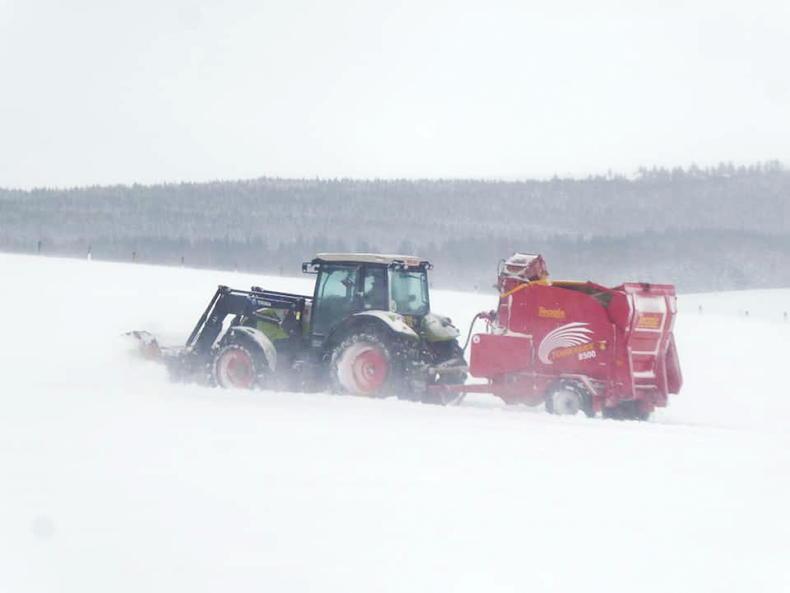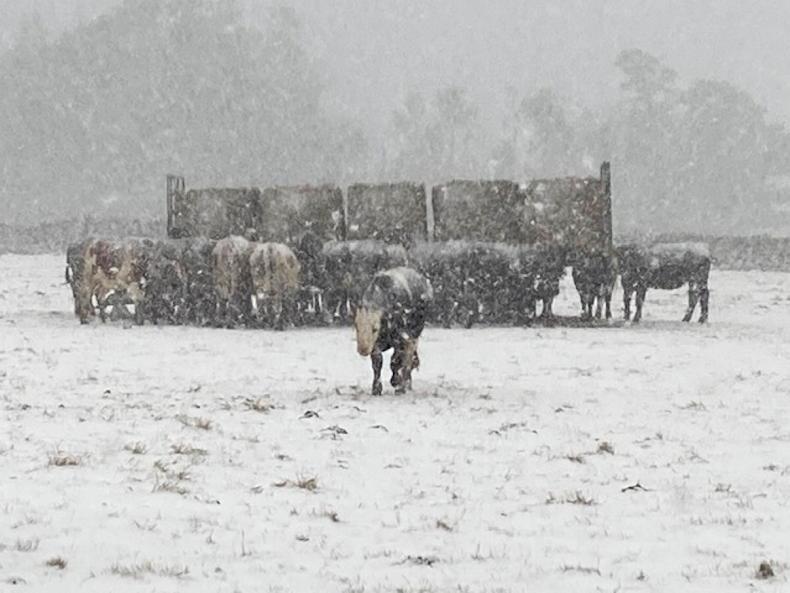In 2016, the Gammies registered 32 calves across three different breeds/crosses. Come 2020, with the expansion plans well under way, they registered 74 calves from just one breed/cross. There are more than double the number of calves now being born on the farm.
In 2018, Andrew decided to simplify his suckler herd and concentrate on only Limousin genetics, backing his own pedigree breeding.
All calves born are either pure Limousin or Limousin-cross, with the crosses mainly coming from either Limousin-cross dams or Simmental-Fleckveih dams. This has simplified the system for Andrew and allowed him to concentrate on the animals that he feels suit the system best.

Andy Duffus took three attempts to clear a path up to the sheep in the recent wintery conditions in Tomintoul.
Planning for grazing
As days start to draw longer, the thoughts on the programme farms are turning towards turnout and the upcoming grazing season. With grazed grass costing around 43p per cow per day compared with an inside diet costing 85p to £1 per cow per day, prioritising turnout is key to maximising cattle margins.
Land type at Drumforber is heavy clay and, prior to the project, turnout was in May. Now, with a change of focus, Andrew is achieving a much earlier turnout. In 2017, heifers were at grass in late March and in 2018, after a particularly mild winter, they were grazing in February.
Getting ready for turnout
However, this year, turnout will not be in February, It is looking like it will be late March or perhaps even into April, depending on conditions over the next few weeks.
Since 2018, Andrew has been running grazing lambs on the grass over winter. This means that Andrew carries less grass cover over winter, slightly delaying spring turnout.
Another change brought in through the programme has been to reduce the quantity of fertiliser applied in one dose to the grazing ground and to spread more doses through the season instead.
This gives Andrew more control of growth, increasing grass utilisation. In doing this, since the start of the programme, the Gammies have reduced grassland fertiliser purchase by 17% to 28t, while more than doubling cow numbers.
One of the keys to driving productivity from grass has been the adoption of rotational grazing. This year, Andrew is planning to set up the same rotation as last year.
This sees the farm broken down into blocks for each bulling group of around 30 cows and calves or 20 cows and calves plus 10 to 15 bulling heifers. In the past, better management of grazing allowed Andrew to cut surpluses with the main first cut. He plans to do the same this year.
Agbag is a winner
Last year, Andrew returned to using an agbag for his first cut silage. He had previously used one in the winter of 2017, but did not get on well with it.
The silage was very dry, meaning that it did not keep well and the site became very wet, leading to bad tracking and a lot of silage was wasted.
However, last summer, he laid down a hard standing capped with tar planings for the bag to sit on. This has significantly reduced the waste and with his investment in a heavy duty net to sit on top of the bag, wastage is minimal. He said: “The agbag is great, I wouldn’t really change it to be honest.”
At a cost of £7/t, the agbag is quite competitive compared with building a pit. There is also a lot less plastic to dispose of compared with bales and Andrew has reduced mixing times for the TMR for the cattle, due to a reduced need to chop down the grass.
Commercial bulls will be getting finished this year. In years past, Andrew has struggled for space, meaning that calves were sold as stores. With the construction of a new shed last year, he has a lot more space to work with and will sell all commercial bulls finished.
In 2016, the Gammies registered 32 calves across three different breeds/crosses. Come 2020, with the expansion plans well under way, they registered 74 calves from just one breed/cross. There are more than double the number of calves now being born on the farm.
In 2018, Andrew decided to simplify his suckler herd and concentrate on only Limousin genetics, backing his own pedigree breeding.
All calves born are either pure Limousin or Limousin-cross, with the crosses mainly coming from either Limousin-cross dams or Simmental-Fleckveih dams. This has simplified the system for Andrew and allowed him to concentrate on the animals that he feels suit the system best.

Andy Duffus took three attempts to clear a path up to the sheep in the recent wintery conditions in Tomintoul.
Planning for grazing
As days start to draw longer, the thoughts on the programme farms are turning towards turnout and the upcoming grazing season. With grazed grass costing around 43p per cow per day compared with an inside diet costing 85p to £1 per cow per day, prioritising turnout is key to maximising cattle margins.
Land type at Drumforber is heavy clay and, prior to the project, turnout was in May. Now, with a change of focus, Andrew is achieving a much earlier turnout. In 2017, heifers were at grass in late March and in 2018, after a particularly mild winter, they were grazing in February.
Getting ready for turnout
However, this year, turnout will not be in February, It is looking like it will be late March or perhaps even into April, depending on conditions over the next few weeks.
Since 2018, Andrew has been running grazing lambs on the grass over winter. This means that Andrew carries less grass cover over winter, slightly delaying spring turnout.
Another change brought in through the programme has been to reduce the quantity of fertiliser applied in one dose to the grazing ground and to spread more doses through the season instead.
This gives Andrew more control of growth, increasing grass utilisation. In doing this, since the start of the programme, the Gammies have reduced grassland fertiliser purchase by 17% to 28t, while more than doubling cow numbers.
One of the keys to driving productivity from grass has been the adoption of rotational grazing. This year, Andrew is planning to set up the same rotation as last year.
This sees the farm broken down into blocks for each bulling group of around 30 cows and calves or 20 cows and calves plus 10 to 15 bulling heifers. In the past, better management of grazing allowed Andrew to cut surpluses with the main first cut. He plans to do the same this year.
Agbag is a winner
Last year, Andrew returned to using an agbag for his first cut silage. He had previously used one in the winter of 2017, but did not get on well with it.
The silage was very dry, meaning that it did not keep well and the site became very wet, leading to bad tracking and a lot of silage was wasted.
However, last summer, he laid down a hard standing capped with tar planings for the bag to sit on. This has significantly reduced the waste and with his investment in a heavy duty net to sit on top of the bag, wastage is minimal. He said: “The agbag is great, I wouldn’t really change it to be honest.”
At a cost of £7/t, the agbag is quite competitive compared with building a pit. There is also a lot less plastic to dispose of compared with bales and Andrew has reduced mixing times for the TMR for the cattle, due to a reduced need to chop down the grass.
Commercial bulls will be getting finished this year. In years past, Andrew has struggled for space, meaning that calves were sold as stores. With the construction of a new shed last year, he has a lot more space to work with and will sell all commercial bulls finished.








 This is a subscriber-only article
This is a subscriber-only article










SHARING OPTIONS: